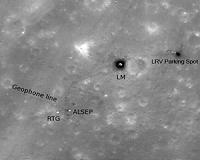 |
Beijing, China (XNA) Jul 19, 2010 China's space agency has set up a committee of 123 leading scientists to consider how the country might apply the vast amount of data acquired by China's first lunar probe. The project had resulted in data about the distribution and content of important elements on the moon, such as uranium, thorium, potassium, aluminum, silicon, iron and titanium, said the State Administration of Science, Technology and Industry for National Defense Friday. China launched its first lunar probe Chang'e-1, named after China's mythical Moon Goddess, on Oct. 24, 2007 in southwestern Sichuan Province. The probe ended its 16-month mission on March 1, 2009, when it hit the lunar surface. The administration said in a statement that China was making "periodic" progress in processing, analyzing and studying the data from the probe, and the "world class" map of the moon's entire surface. The map, produced by a stereo camera using a charge-coupled device (CCD) on the probe to form images, was highly accurate, said Ouyang Ziyuan, chief scientist of China Lunar Exploration Project. Chang'e-1 had produced digital elevation models and a three-dimensional topographical map with the highest possible accuracy and resolution, he said. The probe had also provided researchers with data on the microwave radiation temperatures of the lunar regolith, the powdery soil layer on the moon's surface, which was significant to identify the thickness of the regolith and the rare gases within it, said Ouyang. "Unique" data about the high-energy particles in near-lunar space and solar-wind particles had also been obtained, which would enrich knowledge about solar radiation, the magnetic field between the sun and the earth, and the moon, Ouyang said. The scientists, from some of China's leading research institutions and universities, would consider about 2.76 terabytes (TB) of data generated from the 1.37 TB of information sent back from Chang'e-1, said Ouyang.
Source: Source: Xinhua
Share This Article With Planet Earth
Related Links - Mars News and Information at MarsDaily.com Lunar Dreams and more
 Apollo 16: Footsteps Under High Sun
Apollo 16: Footsteps Under High SunWashington DC (SPX) Jul 09, 2010 The lunar module Orion landed in the Descartes Highlands of the moon on April 21, 1972. The Apollo 16 mission targeted a highland region. Originally thought to be a volcanic site, the samples returned by Apollo 16 actually indicated that the highlands of the moon primarily consist of impact-formed rocks (breccias), a substantial scientific result. The featured image is an LROC NAC image of ... read more |
|
| The content herein, unless otherwise known to be public domain, are Copyright 1995-2010 - SpaceDaily. AFP and UPI Wire Stories are copyright Agence France-Presse and United Press International. ESA Portal Reports are copyright European Space Agency. All NASA sourced material is public domain. Additional copyrights may apply in whole or part to other bona fide parties. Advertising does not imply endorsement,agreement or approval of any opinions, statements or information provided by SpaceDaily on any Web page published or hosted by SpaceDaily. Privacy Statement |